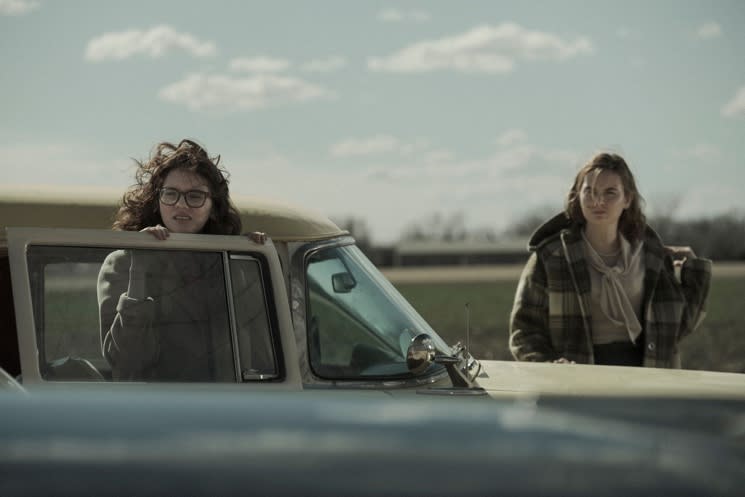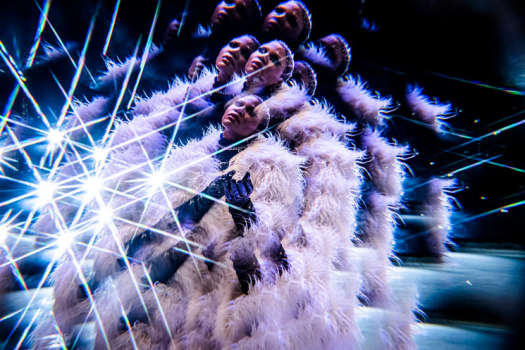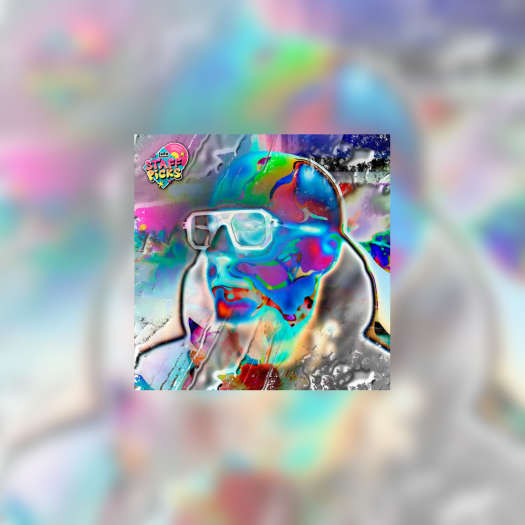Lesbian narratives have had a strong few years – you could even say a strong decade. While they still pale in comparison to films that focus on heterosexual relationships, what's lacking in the lesbian film canon (and bisexual canon) are more films that focus on teens. The Miseducation of Cameron Post, Princess Cyd and Booksmart are some standout examples — and much like Booksmart, To the Stars' primary focus isn't on sexuality, but on the friendship between its two female protagonists. That is, until it leans into tropes and presents the lesbianism of its narrative in the most exhausted and dangerous way.
To the Stars begins with an emphasis on Heather McIntosh's score, which fits perfectly with the tone that's wrapped around most of the film. Director Martha Stephens' images of 1960s small-town Oklahoma were first seen on the festival circuit in black and white, and while it would have been wonderful if they had remained so, the cinematography by Andrew Reed is still eye-catching, making a big impression right from its opening shots.
The film follows two high school girls in a time of strict convention, oppressive to anyone who wasn't straight and white (and male). The first is Iris, a shy, bespectacled bookworm who has no friends and endures daily doses of bullying from her classmates. But then she meets new girl Maggie. With the sound of a rock hitting a boy's skull, this feisty city girl with a mouth like a gutter instantly becomes Iris's protector. It's a satisfying, amusing beginning to a friendship. If you were ever described as "awkward," "too quiet" or ever prayed to the stars to disappear, you'll see yourself in Iris, as Kara Hayward plays the role with ease. In contrast, Maggie is the outgoing joker, and Liana Liberato brings a lot of charisma to her part. The camaraderie between them, the touching friendship that develops feels like comfort food and really saves the film. They find solace in their shared loneliness as these are two teenagers unable to be comfortable in their own skin. Especially Maggie, who, while making it her duty to bring Iris out of her shell, has made a persona for herself. Like Iris, Maggie is desperate to be liked so she makes up stories to impress her peers, and Liberato excels at playing enigmatic because the character depends on it: she's a lesbian and her façade mustn't crack.
While To the Stars is set in the '60s, it feels like a modern and relatable high school drama. There are mean girls, jocks, cheerleading, prom, and actors that look like they belong there (unlike other depictions of high schools of the era, like Grease). Outside of the high school setting, we are given glimpses of Iris and Maggie's family life and the flaws within. They both come from toxic households. Maggie comes from an upper-middle-class home: the image of the perfect American family on the surface, but her father (Tony Hale, far from his role in Veep) is stern, abusive and angry at having to give up his job and move because of his daughter's indiscretions. In contrast, Iris is a farmer's daughter, but love is no longer found between her parents (played by Jordana Spiro and Shea Whigham). She's from the family who's the butt of every joke from her wealthier classmates. Despite being from different backgrounds, both Iris and Maggie are made to feel like disappointments to their parents, just another thing that brings them closer together.
The film's screenwriter, Shannon Bradley-Colleary, takes care to flesh out its characters, even secondary ones are fleshed out more than some films ever do. There's also some wonderful dialogue and intimate conversations between characters that have the kind of emotional impact you don't get from every film. There's a lot to love, but especially the beautiful friendship that's absent of any kind of prejudice, which is quite refreshing to see when you consider the period. It's a perfect image of the '60s, and an honest depiction of society of the era in the American South. It's a film about women oppressed who yearn for more, or yearn for what they can't have. It explores the pain of being forced to suppress who you are. This isn't only explored with Maggie; turns out, she's not the only one in town hiding her sexuality. But when secrets come out and scandal erupts, it falls into the same trappings that have sunk other period-set LGBT stories.
When Maggie reaches her breaking point, she comes out to Iris, heartbreakingly, in a moment of self-disgust. It's a scene reminiscent of the one between Shirley MacLaine and Audrey Hepburn in 1961's The Children's Hour. It's a powerful scene, as this self-hatred and internalized homophobia is still real for many. But she is accepted. Scenes like these are relatable for teens — but what's dangerous is when it's combined with the outdated and overused representations of sexuality alongside its historical oppression or repression, particularly in the Western world. To the Stars, through the depiction of violence and lack of any kind of resolution to its lesbian theme, turns into another film that suggests that a lesbian's life can only be a miserable and lonely one – or, if you're bisexual, that you'll only ever find happiness in the arms of a man. Period-set films like these can work without being filled with fear or with any kind of negative reaction to lesbianism despite the times – it's been done before.
Hollywood churns out mediocre films about heterosexual teens several times a year, and as much as closeted women yearned for acceptance and love, To the Stars makes you yearn for mediocre feel-good teen movies that young lesbians and bisexuals can find solace in.
To the Stars begins with an emphasis on Heather McIntosh's score, which fits perfectly with the tone that's wrapped around most of the film. Director Martha Stephens' images of 1960s small-town Oklahoma were first seen on the festival circuit in black and white, and while it would have been wonderful if they had remained so, the cinematography by Andrew Reed is still eye-catching, making a big impression right from its opening shots.
The film follows two high school girls in a time of strict convention, oppressive to anyone who wasn't straight and white (and male). The first is Iris, a shy, bespectacled bookworm who has no friends and endures daily doses of bullying from her classmates. But then she meets new girl Maggie. With the sound of a rock hitting a boy's skull, this feisty city girl with a mouth like a gutter instantly becomes Iris's protector. It's a satisfying, amusing beginning to a friendship. If you were ever described as "awkward," "too quiet" or ever prayed to the stars to disappear, you'll see yourself in Iris, as Kara Hayward plays the role with ease. In contrast, Maggie is the outgoing joker, and Liana Liberato brings a lot of charisma to her part. The camaraderie between them, the touching friendship that develops feels like comfort food and really saves the film. They find solace in their shared loneliness as these are two teenagers unable to be comfortable in their own skin. Especially Maggie, who, while making it her duty to bring Iris out of her shell, has made a persona for herself. Like Iris, Maggie is desperate to be liked so she makes up stories to impress her peers, and Liberato excels at playing enigmatic because the character depends on it: she's a lesbian and her façade mustn't crack.
While To the Stars is set in the '60s, it feels like a modern and relatable high school drama. There are mean girls, jocks, cheerleading, prom, and actors that look like they belong there (unlike other depictions of high schools of the era, like Grease). Outside of the high school setting, we are given glimpses of Iris and Maggie's family life and the flaws within. They both come from toxic households. Maggie comes from an upper-middle-class home: the image of the perfect American family on the surface, but her father (Tony Hale, far from his role in Veep) is stern, abusive and angry at having to give up his job and move because of his daughter's indiscretions. In contrast, Iris is a farmer's daughter, but love is no longer found between her parents (played by Jordana Spiro and Shea Whigham). She's from the family who's the butt of every joke from her wealthier classmates. Despite being from different backgrounds, both Iris and Maggie are made to feel like disappointments to their parents, just another thing that brings them closer together.
The film's screenwriter, Shannon Bradley-Colleary, takes care to flesh out its characters, even secondary ones are fleshed out more than some films ever do. There's also some wonderful dialogue and intimate conversations between characters that have the kind of emotional impact you don't get from every film. There's a lot to love, but especially the beautiful friendship that's absent of any kind of prejudice, which is quite refreshing to see when you consider the period. It's a perfect image of the '60s, and an honest depiction of society of the era in the American South. It's a film about women oppressed who yearn for more, or yearn for what they can't have. It explores the pain of being forced to suppress who you are. This isn't only explored with Maggie; turns out, she's not the only one in town hiding her sexuality. But when secrets come out and scandal erupts, it falls into the same trappings that have sunk other period-set LGBT stories.
When Maggie reaches her breaking point, she comes out to Iris, heartbreakingly, in a moment of self-disgust. It's a scene reminiscent of the one between Shirley MacLaine and Audrey Hepburn in 1961's The Children's Hour. It's a powerful scene, as this self-hatred and internalized homophobia is still real for many. But she is accepted. Scenes like these are relatable for teens — but what's dangerous is when it's combined with the outdated and overused representations of sexuality alongside its historical oppression or repression, particularly in the Western world. To the Stars, through the depiction of violence and lack of any kind of resolution to its lesbian theme, turns into another film that suggests that a lesbian's life can only be a miserable and lonely one – or, if you're bisexual, that you'll only ever find happiness in the arms of a man. Period-set films like these can work without being filled with fear or with any kind of negative reaction to lesbianism despite the times – it's been done before.
Hollywood churns out mediocre films about heterosexual teens several times a year, and as much as closeted women yearned for acceptance and love, To the Stars makes you yearn for mediocre feel-good teen movies that young lesbians and bisexuals can find solace in.




